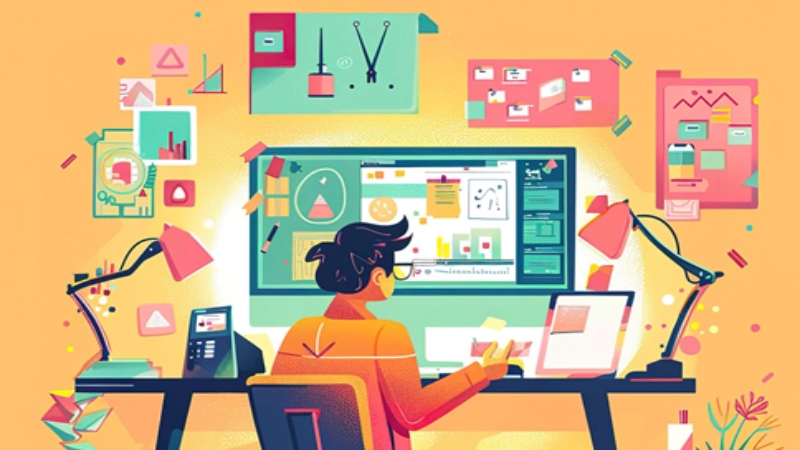Blog / Creating an Unique Graphic Design Portfolio: Tips & Tricks for 2024

Monday, 1 Jul 2024
Creating an Unique Graphic Design Portfolio: Tips & Tricks for 2024
Hello, future design superstar!
Are you ready to dive into the exciting world of graphic design and showcase your creative talents to the world? Whether you’re just starting out or looking to revamp your existing portfolio, 2024 is the perfect time to make your mark. In this blog, we’ll walk you through everything you need to know about creating a stunning graphic design portfolio that will wow potential clients and employers alike. Let’s get started!
What is a Graphic Design Portfolio?
A graphic design portfolio is your visual resume. It’s a curated collection of your best work that showcases your skills, creativity, and design process. Think of it as your personal gallery, where each piece tells a story of your journey as a designer. It’s not just about showing what you’ve done; it’s about highlighting how you think and solve problems through design.
Uses for Graphic Design Portfolios
It serves multiple purposes:
- Job Applications: Employers want to see your style and capabilities.
- Client Work: Potential clients look at your portfolio to decide if you’re the right fit for their project.
- Freelancing: Helps you stand out in a competitive market.
- Networking: Makes it easier for other graphic designers to see your work and collaborate.
Whether you’re applying for a job, seeking freelance gigs, or simply networking within the industry, your portfolio is your ticket to showcase your talent and landing opportunities.
How to Build Your Graphic Design Portfolio
Now, let’s break down how you can build a portfolio that stands out in 2024.
Select a Platform
Choose an online platform that supports responsive web design so your portfolio looks great on all devices. Popular choices include:
- Behance.
- Adobe Portfolio.
- Wix.
- WordPress.
- Squarespace.
- Create a personal website.
Identify Your Target Audience
Understanding who you’re designing for is crucial. Are you targeting potential employers, clients, or a specific niche like digital designs or branding projects? By clearly identifying your target audience, you can create a more focused and impactful portfolio that speaks directly to the people you want to impress.
Curate Your Portfolio
Select your best work and make sure it’s well-organised. Include a variety of projects, from typography and brand design to animation design and motion graphics. A well-curated and organised portfolio will demonstrate your versatility and skill set.
Create a Cohesive Visual Style
Make sure to maintain a consistent style throughout. Use a harmonious colour scheme, consistent typography, and a clean portfolio layout for a polished and professional presentation.
- Colour Scheme: Opt for a palette that enhances your work without overpowering it.
- Typography: Pick fonts that are both easy to read and match your design aesthetic.
- Portfolio Layout: Utilise a clean and structured layout to ensure easy and enjoyable navigation.
Kick off with an eye-catching cover page and an engaging introduction that showcases your design philosophy, skills, and experience. This cohesive visual style will make your work more memorable and professional.
Highlight Your Unique Skills
Showcase the specific design tools and design software you excel in. Highlighting your design process can give viewers insight into how you approach and solve design challenges.

Make It Interactive and Engaging
Incorporate elements that make your digital portfolio interactive. For graphic designers, adding interactive elements can make your portfolio more engaging and memorable. Think about how you can use animations, hover effects, or embedded videos to bring your work to life. To make sure your portfolio is user-friendly, organize it with clear headings, subheadings, and a logical menu structure. Adding a table of contents or a navigation bar will allow viewers to easily move between sections. Enhance your presentation by including multimedia elements like GIFs, videos, and prototypes, which are particularly crucial for demonstrating UI/UX design and motion graphics in action.
Optimise for SEO
Ensure your portfolio is search engine friendly. Use relevant keywords in your descriptions, titles, and metadata. This will help potential clients and employers find your work online.
Stay Updated with Trends
The design industry is always evolving. Keep your portfolio current by following industry trends then updating it regularly with your latest projects and incorporating a blog or news section to add value and keep your audience engaged.
Seek Feedback and Iterate
Always be open to hear client feedback or advice from fellow designers. Use this input to refine and improve your portfolio continuously.
Showcase Your Personality
Let your personality shine through your portfolio. Share your story, your passion for design, and what makes you unique. Personal touches make your portfolio more relatable and memorable.
Present Your Portfolio Professionally
Your presentation skills matter. Make sure your portfolio is easy to navigate, visually appealing, and professionally presented. Paying close attention to the little things can create a significant impact.
Conclusions
Creating a stunning graphic design portfolio takes time and effort, but it’s your best tool for showcasing your talent and landing exciting opportunities. Whether you’re looking to learn graphic design or refine your skills, a well-crafted portfolio is essential.
If you’re eager to dive deeper into the world of graphic design, why not check out our courses at Dreamzone? Our comprehensive graphic design course can help you develop the skills you need to create a standout portfolio. Plus, we have an exciting competition called Anigra’24 with categories in graphic design, animation, and short films. The theme is Dreamscape, and the winner will take home a 2 lakh cash prize!
For more information, visit our Dreamzone website and start your journey to becoming a top-notch designer today!
Frequently Asked Questions

Corporate Headquarters
1st Floor, K.R. Ahamed Sha office complex, No. 25, Dr. Radhakrishnan Salai, Mylapore,
Chennai - 600 004, Tamil Nadu, India.
Flagship Events
Trending Courses
Fashion Design
Interior Design





